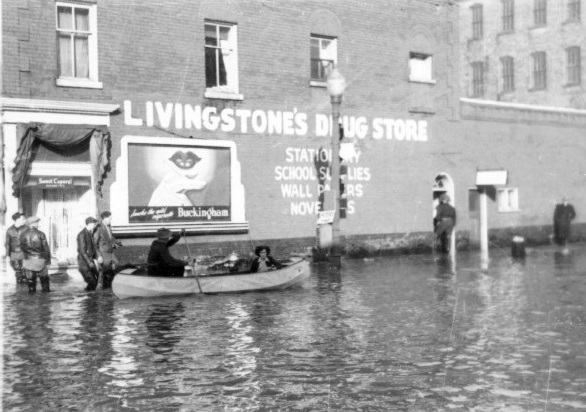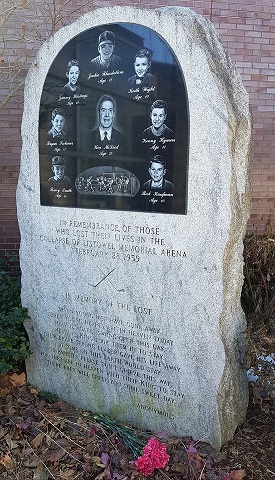Andrew McKeever
Many heroes in Elma, Listowel and Wallace served and sacrificed their lives during the wars of the 20th century. The Listowel and Atwood Cenotaphs honour and remember soldiers lost in WWI, WWII, and the Korean War. An Afghanistan War Memorial was placed at the Listowel Cenotaph in 2017.
Andrew McKeever became one of the greatest two-seater pilots in the history of aviation. He was born and raised in Elma Township. McKeever survived the war, but after coming home passed away from complications resulting from a car accident. His funeral was conducted with every honour accorded to the highest military official in the British Army.
Cyclone Taylor
Fred “Cyclone” Taylor is North Perth’s very own hockey all-star.
Arriving in Listowel in 1891, 5-year old Taylor refined his hockey skills on the frozen Maitland River. Taylor would skate to school every day during winter.
Taylor went on to play for junior, intermediate, and professional teams across Canada and in the USA.
As a defenseman for the Ottawa Hockey Club, Taylor earned the nickname “Cyclone” through his ability to use his speed to jump into offensive rushes. Taylor was a top scorer, won two Stanley Cups, and continuously selected for the All-Star Team.
Throughout his hockey career, Taylor worked for the Government of Canada. He eventually became the Commissioner of Immigration for British Columbia and the Yukon.
In 1945, “Cyclone” Taylor was elected as a charter member of the Hockey Hall of Fame. He was also given the honour of turning the sod for the construction of the Hockey Hall of Fame building that opened in 1961. In 1966, Taylor was inducted into Canada’s Hockey Hall of Fame.
In tribute to his impressive hockey career and childhood roots, all Listowel hockey teams have carried the name “Cyclones” since 1974.
Horatio Walker
Horatio Walker was a self-taught, widely respected and commercially successful Canadian painter. He worked with oils and watercolours, often depicting scenes of rural life in Canada.
Horatio was born in May 1858 in Listowel. His father, Thomas Walker, built his home on the site of John Binning’s original log cabin. Walker’s home is now known as the Hardwood Haven, located on Main Street West. Walker built the original part of the house.
At the age of 15, Horatio moved to Toronto to apprentice in the art field.
John Binning
John Binning first settled the area now known as Listowel in 1852.
Binning was born in 1812 in England. He made his way to Canada after serving in the army for many years. He first settled in Hamilton, and then in 1852 made his way to the Queen’s bush with his first wife and young son. The family eventually came upon a deserted shack.
Even though the shack was deserted, Binning felt the need to try to find the original owner. After many weeks of searching, he learned a man surnamed Henry had occupied the shack and claimed the land. After some continued searching, Binning was able to locate Henry and made a deal with Henry for 200 acres of land, stretching from the corner of Main St. W. and Wallace Ave. N. to the property of what is now Hardwood Haven (555 Main St. W.). Binning offered Henry a gun as payment and the agreement was written by the point of a burnt stick on a piece of birch bark.
W.H. Hacking was the first postmaster and general storekeeper in Listowel. The Post Office opened in 1856. There was a desire to have the Post Office and settlement called Mapleton. However, the name was already taken by our neighbours. Therefore, the name Listowel was chosen as the new name for the settlement and office. Listowel was chosen after a town in Ireland, as the majority of early settlers were of Protestant Irish origin.
John Binning was married three times. His first wife was Amy Dodds. She was Binning’s wife when he first travelled to the Queen’s bush. They had four sons and one daughter. Binning’s second wife was Jane Reynolds. She died at the age of 22 and gave birth to one son with Binning. Binning’s third wife was Sarah Cowan. They had no children.
John Binning died in 1899 at the age of 87 years. In his long life in Listowel, he was a prominent figure at Council. He had steadfast opinions and was a tower of strength to the Town’s best interests. He was one of the oldest members of Knox Presbyterian Church and deeply respected by all. He was laid to rest in the Listowel Fairview Cemetery.
John Livingstone Sr.
John Livingstone Sr. was one of the original North Perth pioneers and a very successful businessman. He was the brother of Dr. David Livingstone, a famous African explorer.
Born in Scotland, Livingstone travelled to Canada in 1840, settling in Lanark County, where he operated a successful mercantile business for 20 years. In 1860, Livingstone moved to Listowel, where he built up a large and prosperous trade until his retirement in 1873.


